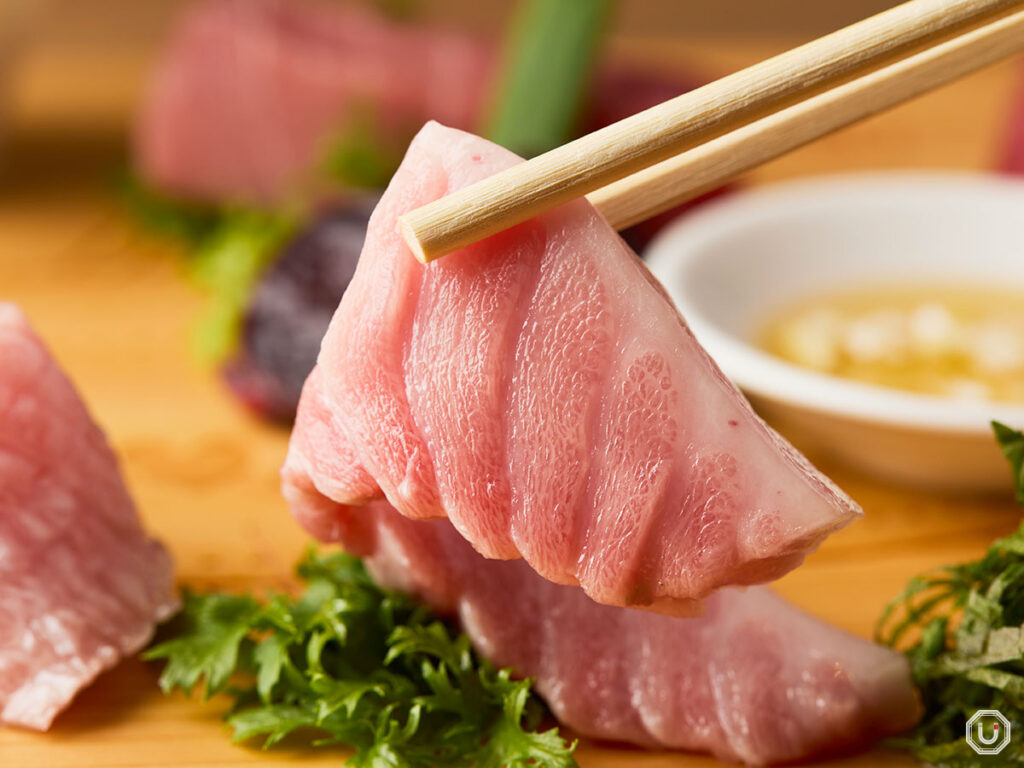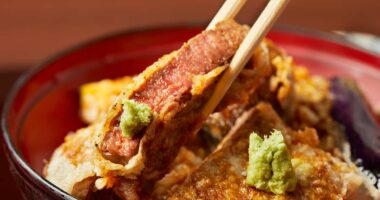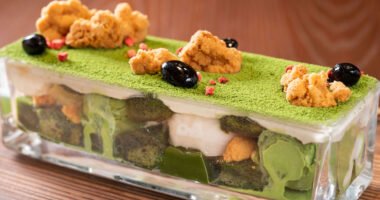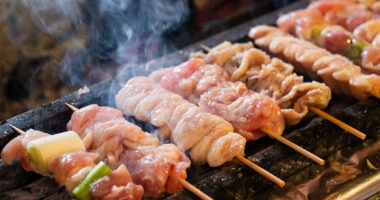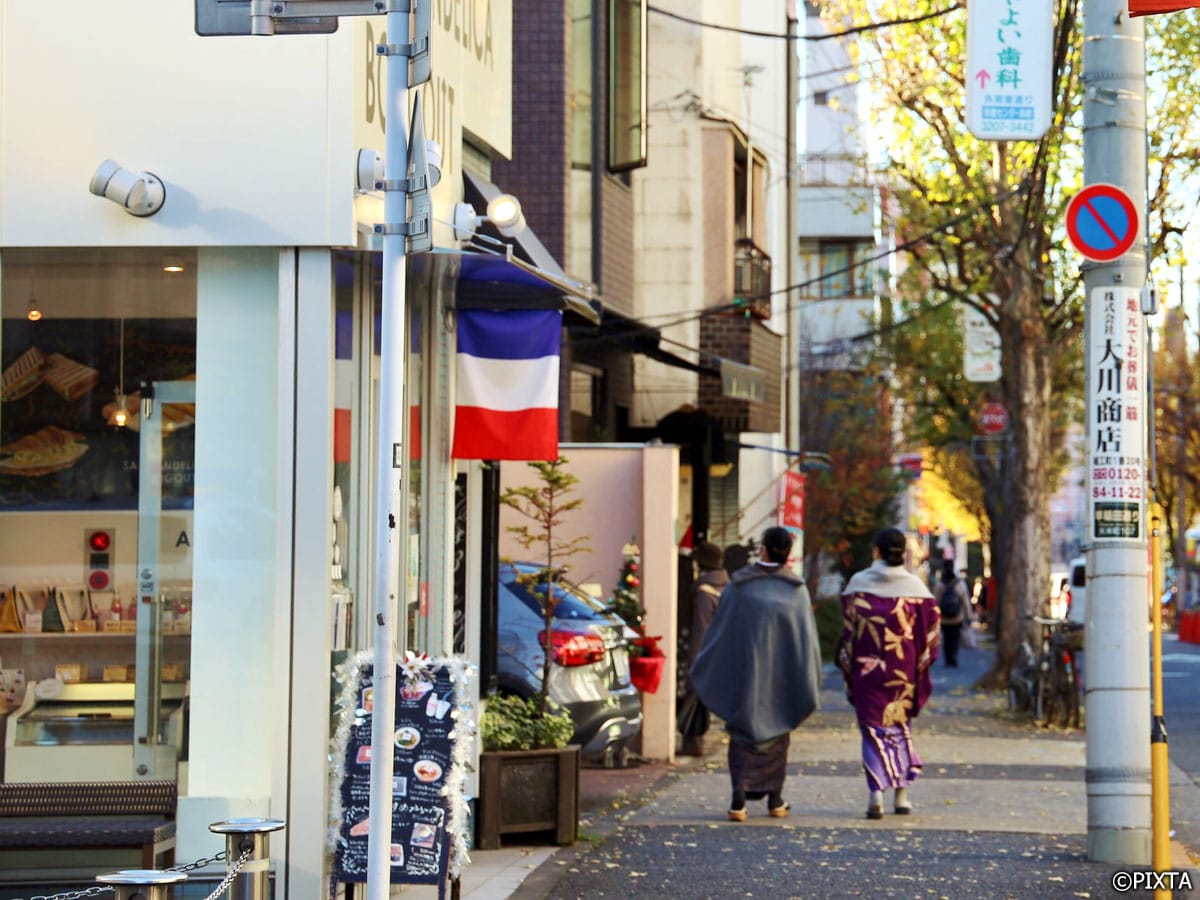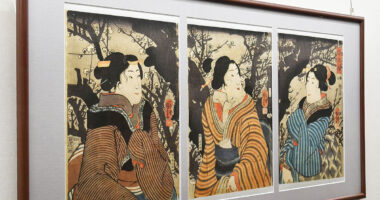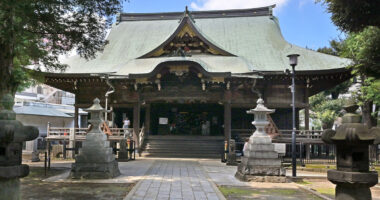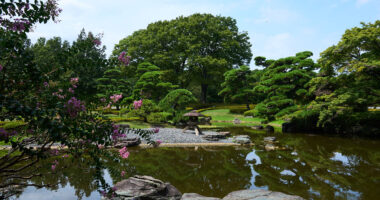Japan is said to have the highest tuna consumption in the world.
In Japan, you can enjoy tuna (maguro) in various dishes, with sushi being the most prominent.
Additionally, some restaurants offer rare cuts, making Japan the perfect place to fully indulge in the joys of tuna.
In this article, you can learn about the characteristics of different tuna cuts and discover the best ways to enjoy them, and experience the allure of this remarkable fish!
- Types of tuna and their peak seasons
- The many cuts of tuna
- Recommended ways to eat tuna: from otoro to the eye
- Otoro: enjoy its natural flavor as sashimi
- Chutoro: a sushi fan-favorite
- Akami: a lean cut with refreshing taste
- Hoho-niku: tuna cheek with meaty texture and flavor
- Shinzo: a rare part with a unique, addictive texture
- Kamatoro: a fattiness that surpasses Otoro?!
- Noten: a cut with meaty texture
- Shirako: a standout dish showcasing culinary creativity
- Medama: stewed eye similar to braised pork belly
- Where to eat both classic and rare cuts of tuna
Types of tuna and their peak seasons
There are five main types of tuna commonly available in Japan:
The main types of tuna are hon-maguro (Pacific bluefin tuna), referred to hereunder by its common name “bluefin tuna,” minami-maguro (southern bluefin tuna), mebachi-maguro (bigeye tuna), kihada-maguro (yellowfin tuna), and binnaga-maguro (albacore tuna).
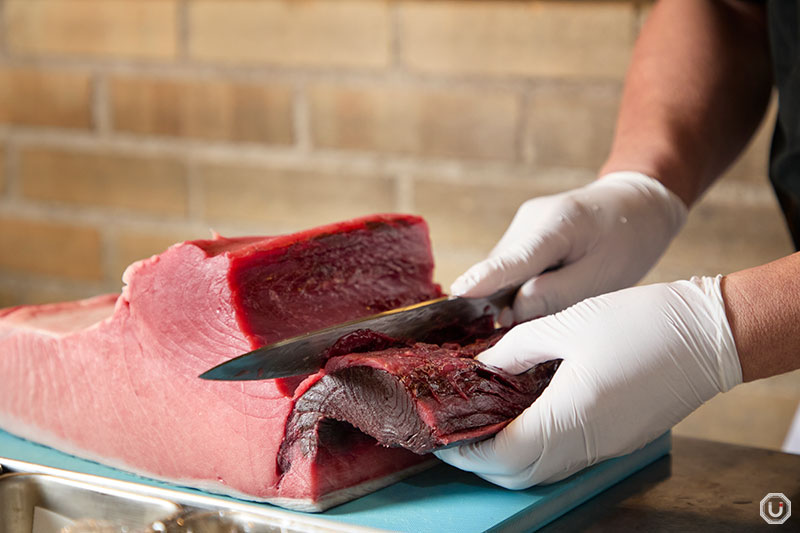
- Bluefin tuna: Considered the most premium among the five types. Bluefin caught in waters near Japan is in season during winter.
- Southern bluefin tuna: In season from spring to autumn and often regarded as the second most premium type after bluefin.
- Bigeye tuna: Found in many ocean regions worldwide. Bigeye caught near Japan has two peak seasons: fall to winter, and spring.
- Yellowfin tuna: Like bigeye, it’s found in many regions. In season from summer to fall.
- Albacore tuna: In season from spring to summer. This type is also commonly used in canned tuna.
Tuna is available year-round, and many restaurants source the best tuna available during each season.
The taste varies not only by type but also between farmed and wild-caught tuna. Thanks to advances in technology, farmed tuna can now offer a high-quality taste, although wild tuna remains highly valued.
Wild-caught bluefin tuna from Japan’s waters is a rare delicacy, making up only a small percentage of the global catch. The price reflects its rarity, but it is considered the king of fish that everyone should try at least once.
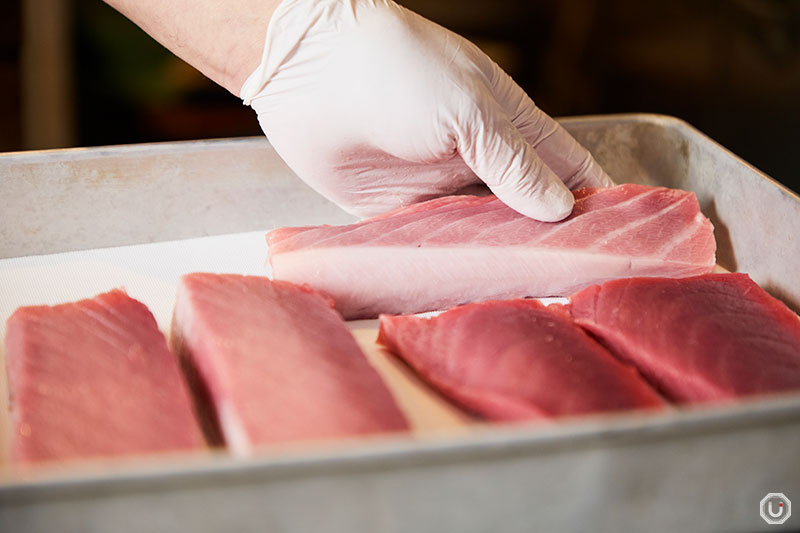
The many cuts of tuna
The reason tuna is called the king of fish is partly due to its diverse cuts, which offer a wide range of flavors.
Some cuts have a refreshing taste, while others offer a rich, meaty juiciness. There is a vast array of delicious options to enjoy.
Standard and rare parts
- Ōtoro: From the belly area of the tuna, very rich and pleasantly fatty.
- Chūtoro: From the back side and the tail end of the belly. It has a good balance of lean meat and fat and is often called medium-fatty tuna in English.
- Akami: A lean cut from the back of the tuna, with a refreshing taste.
- Hoho-niku: A rare part from near the gills, and a constantly moving muscle.
- Shinzō: The tuna’s heart, a rare part that is uncommon at restaurants.
- Kamatoro: A particularly fatty part from behind the gills.
- Nōten: A rare cut from near the tuna’s brain.
- Shirako: Tuna milt. Few restaurants serve this rare part.
- Medama: The tuna’s eyeballs. They have a gelatinous texture and are rich in nutrients.
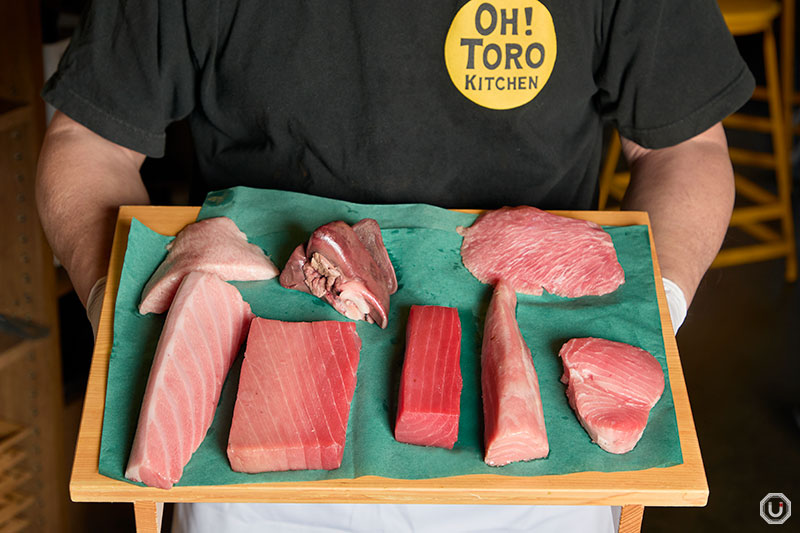
Recommended ways to eat tuna: from otoro to the eye
Because each cut offers a unique flavor, there are many ways to enjoy tuna beyond sushi or sashimi. It can be grilled, simmered, or fried, with each preparation highlighting different aspects of its taste.
A great place where you can fully appreciate the charm of different tuna cuts is “Fishmonger’s Kitchen OH! TORO KITCHEN,” (referred to hereafter as “OH! TORO KITCHEN”) which has three locations in Tokyo: Shibuya, Shimbashi, and Tamachi.
With the help of chef Masao Ōtsuki, who is involved in the restaurant’s culinary development, we’ll introduce the characteristics of each tuna part and recommended ways to enjoy them through actual dishes served at the restaurant.
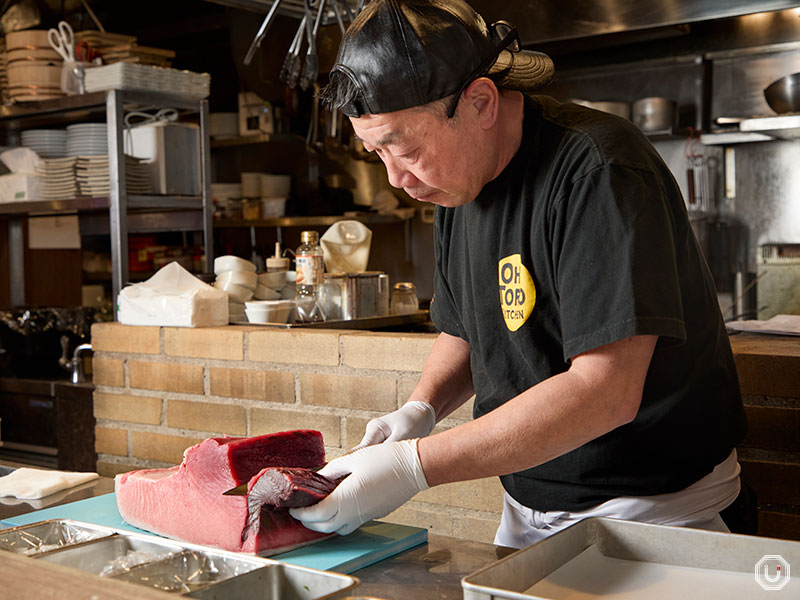
Chef Masao Otsuki, who is behind the recipes at OH! TORO KITCHEN
Otoro: enjoy its natural flavor as sashimi
Otoro is a classic tuna part. Only a small amount can be harvested from each fish, making it a luxury ingredient.

Its standout characteristic is its high fat content. And among all parts, it has the sweetest fat. To fully appreciate its natural flavor, it’s best eaten raw.
If you want to try otoro as sashimi at OH! TORO KITCHEN, you should order the “OH! TORO KITCHEN Tuna Sashimi Assortment, ”a signature dish allowing you to compare several tuna parts.
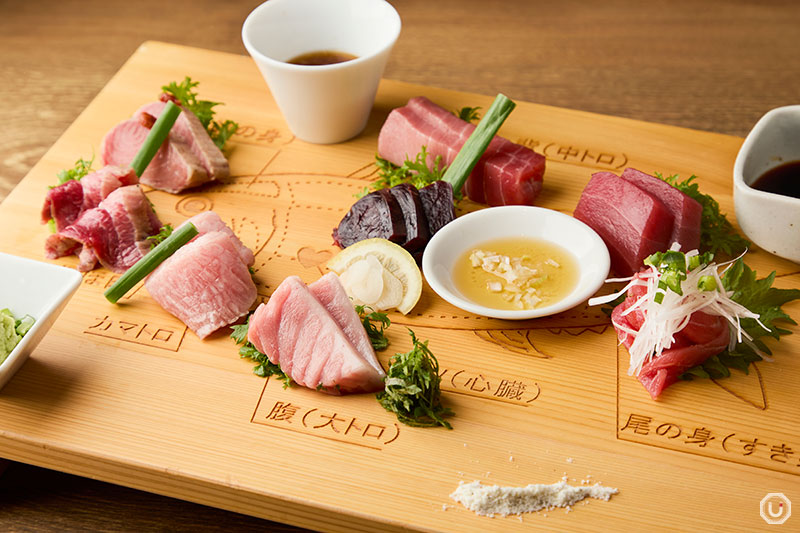
“OH!トロキッチン盛り 8点,” OH! TORO KITCHEN 8 Kinds of Tuna Sashimi Assortment 2,980 JPY (tax included)
The texture melts on your tongue, and the fatty richness delivers an exquisite and luxurious taste that only otoro can offer.
Because of its fatty content, otoro is paired with grated daikon radish and ponzu sauce or truffle salt. These help balance the rich aftertaste.
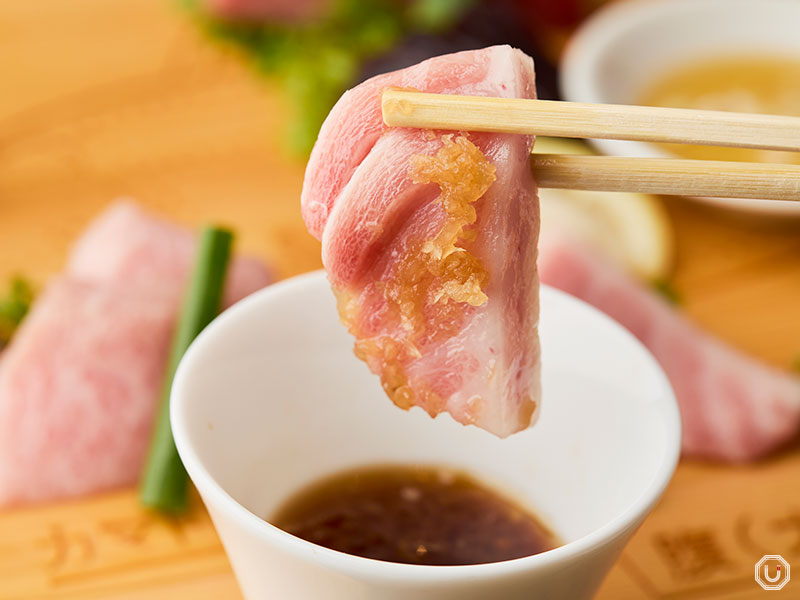
Otoro sashimi
Despite its current popularity, otoro was once discarded during the Edo period because of its high fat content.

In the past, Japanese people consumed little fat. Eating fatty otoro often caused stomach issues. That’s why otoro was thrown away.
Additionally, fatty foods spoil quickly, and without modern refrigeration methods, this was another reason otoro was discarded.
However, when Western culture entered Japan in the early Meiji period, Japanese eating habits changed. Higher-fat foods and dishes increased, refrigeration technology developed, and the previously low-valued otoro began to be appreciated.

Historically, eating tuna’s otoro is a relatively recent development. Eating it raw is even more recent.
Chutoro: a sushi fan-favorite
Chutoro, with its perfect balance of fat and lean meat, is as popular as otoro.

Chutoro combines both the umami of akami’s lean meat and the rich taste of fatty otoro, offering the best of both worlds.
The chutoro used in the restaurant’s “Seared Toro Sushi” is lightly torched with a burner to add a smoky aroma. The melted fat concentrates the umami, further amplifying the satisfaction of each bite.
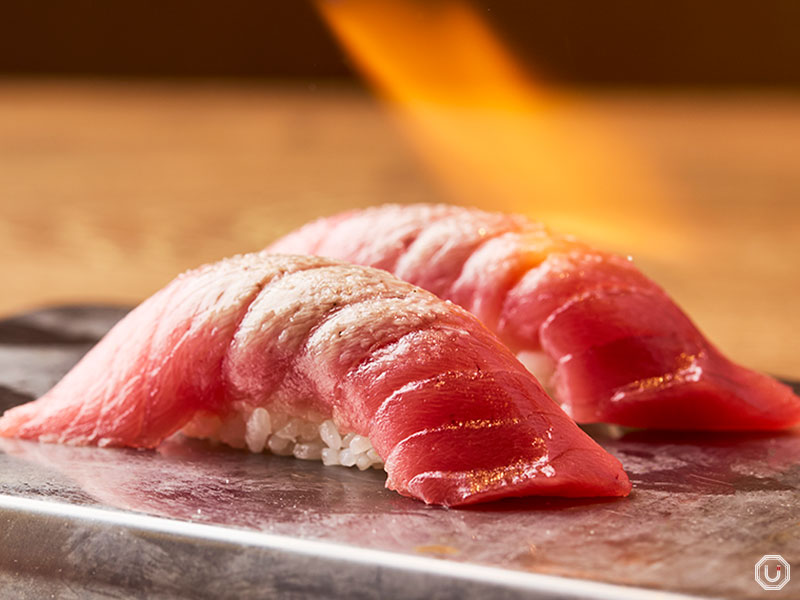
“トロあぶり寿司,” Seared Toro Sushi (which uses chutoro) 450 JPY per piece (tax included)
There’s a particular recommended way to eat the “Seared Toro Sushi.” Since the seared chutoro is sprinkled with a small amount of salt, Otsuki recommends eating it as is without soy sauce.

We source fresh, delicious tuna daily, so eating it simply with salt helps you better appreciate the tuna’s flavor!
Akami: a lean cut with refreshing taste
Akami, which is more affordable than otoro and chutoro, is popular for its satisfying texture that lingers on the tongue.

Even the akami of the bluefin tuna we use at OH! TORO KITCHEN has a juicy flavor despite having less fat. It’s refreshing yet has a fulfilling richness.
Akami has less fat than other tuna parts, making it a healthier option. A single tuna yields a large amount of akami, which can be prepared in various ways.
For example, the restaurant’s “Rare Tuna Katsu” is a dish where akami is coated with breadcrumbs and fried. Since the center is kept rare, it retains a moist texture.
Enjoy it with karashi (a type of spicy Japanese mustard), shiso leaf, and a bit of soy sauce!
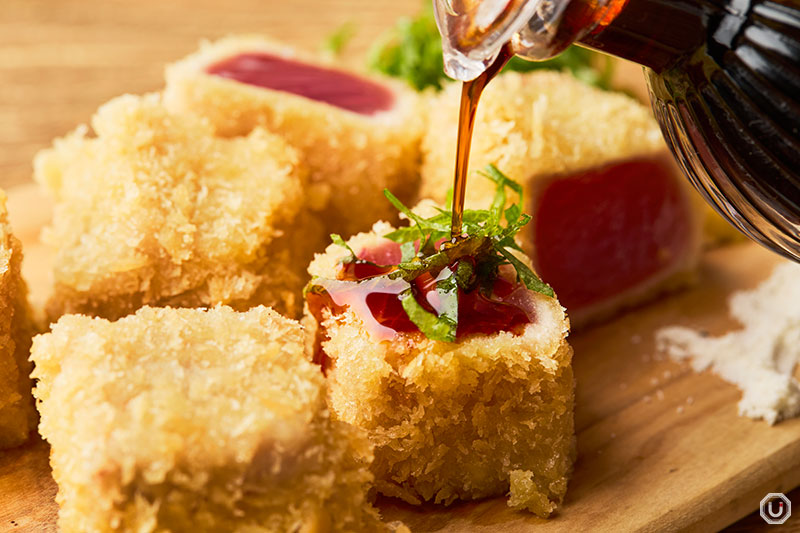
“マグロのレアカツ,” Rare Tuna Katsu (which uses akami) 1,000 JPY (tax included)
The “Tuna Tartare,” inspired by traditional steak tartare made with beef or horse meat, is another dish that uses akami.
The finely cut akami is seasoned with olive oil, French mustard, salt, pepper, and capers. Since akami has such a refreshing taste, it pairs well with a variety of seasonings and is versatile enough to suit both Japanese and Western-style dishes.
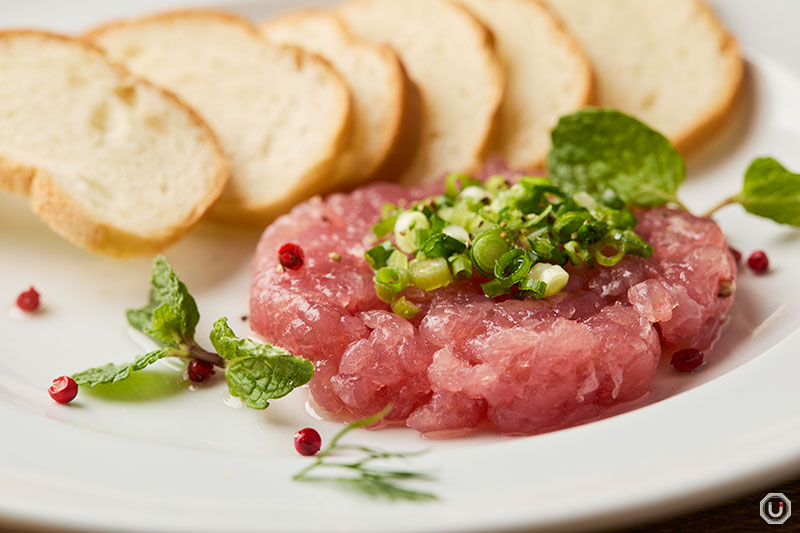
“マグロのタルタル バゲット添え,” Tuna Tartare with baguette (which uses akami) 950 JPY (tax included)
Hoho-niku: tuna cheek with meaty texture and flavor
Hoho-niku, tuna cheek meat, is something you can only savor at specialized restaurants like OH! TORO KITCHEN.

Hoho-niku is located under the gills of the tuna. Since it’s a constantly moving part of the fish, it has almost no fat.
This cheek meat has many silky-soft tendons, which become pleasantly jiggly and tender when cooked.
At OH! TORO KITCHEN, the parts of hoho-niku with fewer tendons are served as sashimi, while those with more tendons are marinated in special miso and grilled as their “Miso-Marinated Grilled Tuna Cheek.”
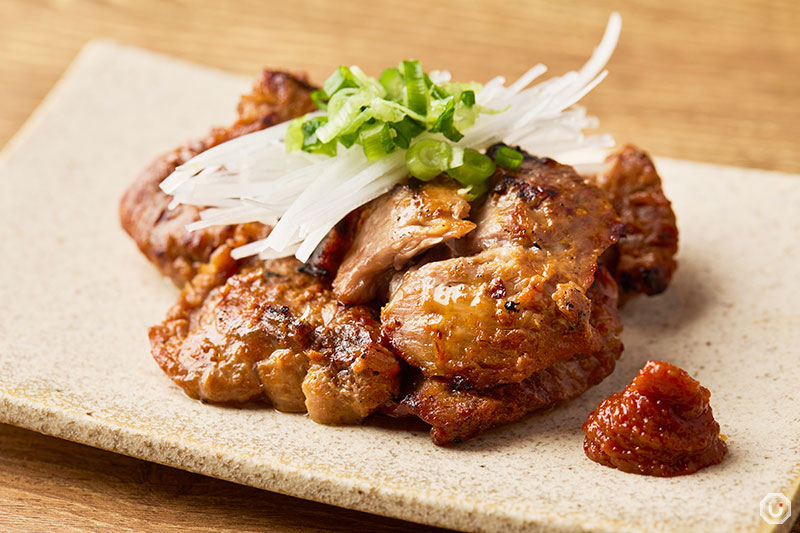
“マグロほほ肉 味噌漬焼き,” Miso-Marinated Grilled Tuna Cheek 780 JPY (tax included)
When heated up, hoho-niku has a texture that resembles chicken thigh meat. The restaurant’s special miso pairs perfectly with it, creating a sweetness that gradually spreads, making it excellent with sake or wine.
Shinzo: a rare part with a unique, addictive texture
Tuna heart is a valued rare part that was originally only eaten by fishermen.
Offering tuna heart, which isn’t widely available in markets, is another advantage that OH! TORO KITCHEN has as a specialized tuna restaurant.

Tuna has a high body temperature and starts to spoil from the stomach. The internal organs must be removed immediately after catching it on the boat, which is why the heart was traditionally only eaten by fishermen.
To fully appreciate the unique texture of tuna heart, it is best enjoyed as sashimi. What makes tuna heart special is its firm yet delicately chewy texture.
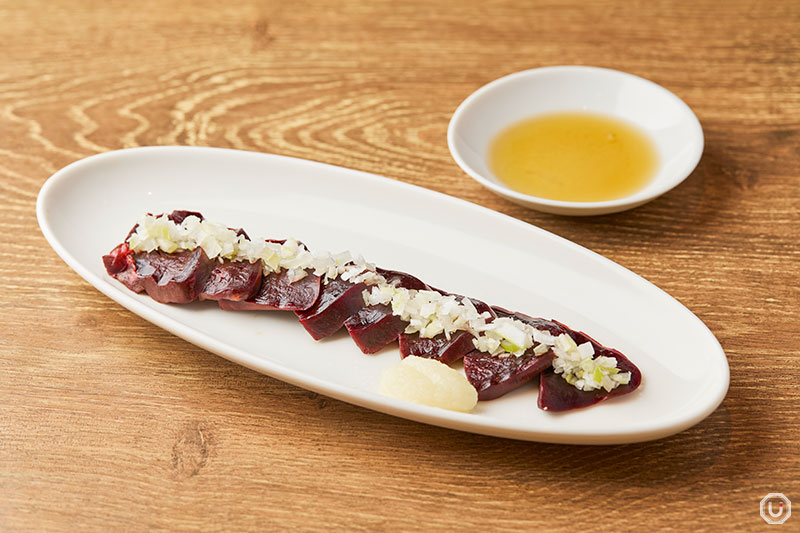
“マグロのハート刺身,” Tuna Heart Sashimi (which uses the rarely found heart) 650 JPY (tax included)
At the restaurant, the heart is carefully rinsed 2-3 times to remove any blood, ensuring there is no unwanted odor. It’s then served with sesame oil and grated garlic.
This rare part is seldom encountered, but once tried, many become addicted to its taste and texture.
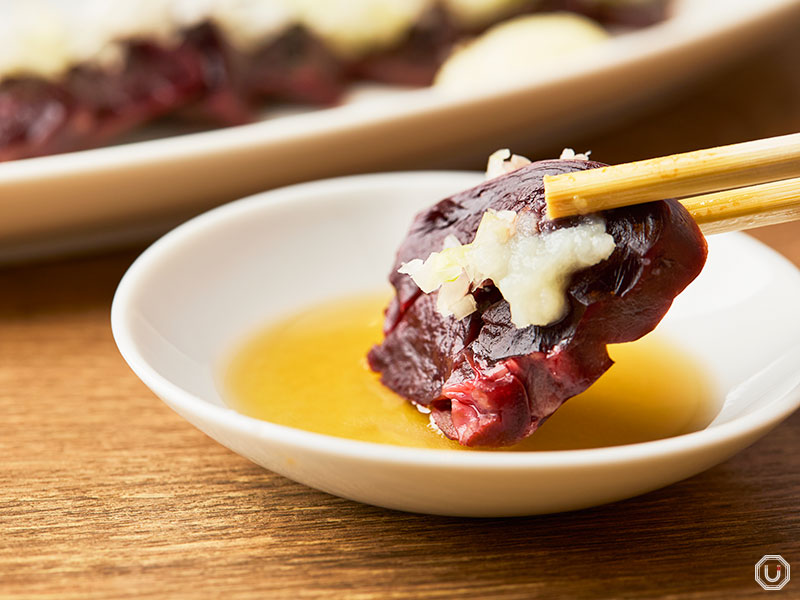
Kamatoro: a fattiness that surpasses Otoro?!
Another rare cut, just like the heart, is kamatoro, taken from behind the gills.

Visually, it looks just like a cut of meat. Kamatoro has as much fat as otoro, but what makes it unique is its marbled sinews, giving it a pleasant bite and chewy texture.
Eating kamatoro raw allows you to fully enjoy its texture and the richness of its fat.
It’s exquisite when enjoyed with a bit of OH! TORO KITCHEN special soy sauce, which has a touch of bonito flavor, along with wasabi. The sweetness of the soy sauce and the kick from the wasabi really elevate the rich fatty flavor of kamatoro.
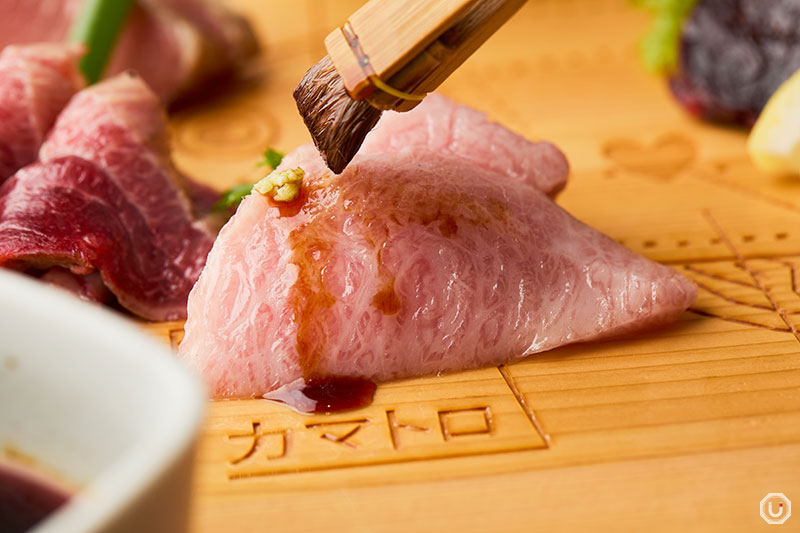
Kamatoro sashimi
Noten: a cut with meaty texture
There are still more cuts of tuna that are quite delicious when enjoyed raw. Noten, taken from around the tuna’s brain, is a cut whose deliciousness is accentuated when paired with spicy miso rather than the usual soy sauce.
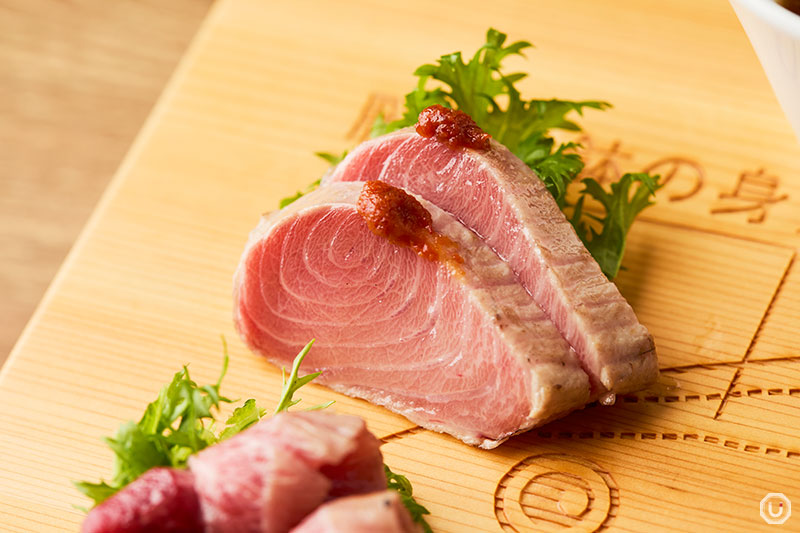
Noten sashimi

Noten has a taste and texture reminiscent of meat. It melts in your mouth and is full of rich fat.
With its bold, punchy flavor, Noten pairs exceptionally well with a spicy miso sauce featuring chili and garlic—OH! TORO KITCHEN’s recommended way to enjoy it.
Shirako: a standout dish showcasing culinary creativity
Shirako is fish milt. Even at OH! TORO KITCHEN, which serves various tuna parts, developing dishes for tuna shirako was particularly challenging.

While the shirako of cod and pufferfish is creamy, tuna shirako is thick and has a firmer texture.
After testing various cooking methods, including tempura frying and simmering, the restaurant created the “Tuna Shirako Bourguignon Butter.”
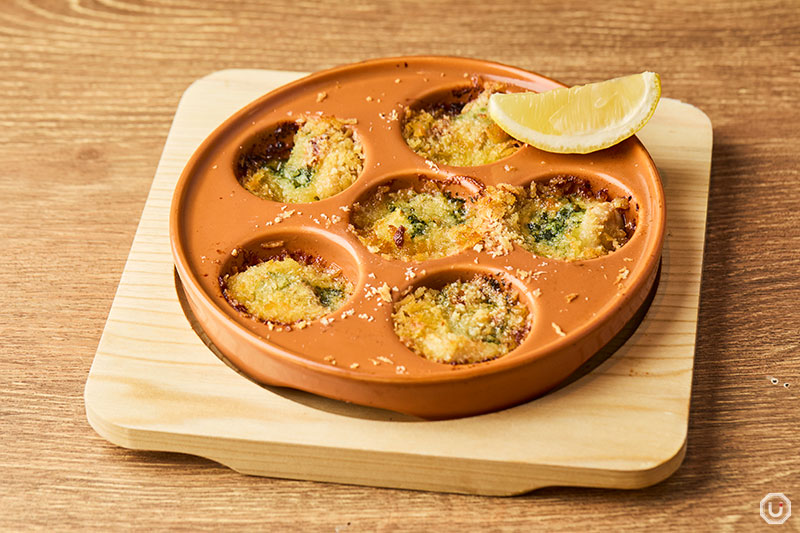
“マグロ白子 ブルギニョンバター,” Tuna Shirako Bourguignon Butter 800 JPY (tax included)

We mix finely chopped garlic, parsley, and salt into butter, spread it over the tuna shirako, coat it with breadcrumbs, and bake it. You can enjoy it as is or pair it with a baguette for an even richer experience.
Medama: stewed eye similar to braised pork belly
Tuna eyeballs are an often-overlooked part of the fish, yet they are packed with nutrients. Many people don’t even realize they’re edible

The eye is gelatinous, so when cooked, it develops a creamy texture. The backside of the eye is especially delicious.
The restaurant’s “Stewed Eye” is made by simmering the tuna’s eyes with soy sauce, mirin, sake, sugar, and ginger, which creates an appetizing aroma.
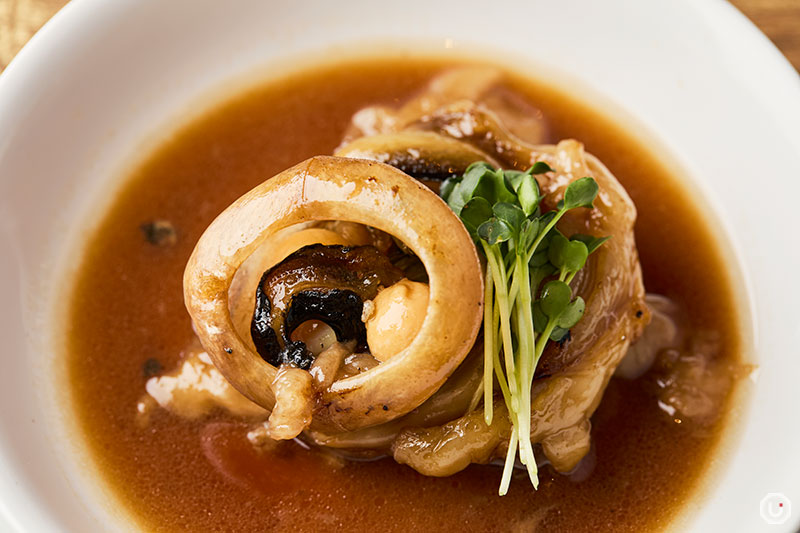
“目玉の煮付け,” Stewed Eye 950 JPY (tax included)
The backside of the eye, recommended by Mr. Otsuki, has a juicy flavor similar to braised pork belly. Its sweet and savory seasoning is rich yet balanced by a subtle ginger flavor.
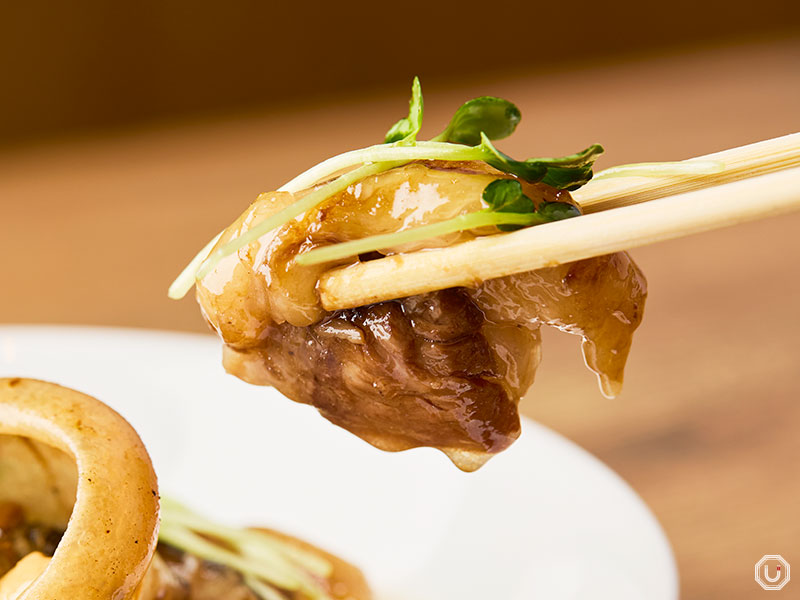
Tuna is an essential part of Japanese cuisine, and ways to enjoy it go far beyond sushi and sashimi.
The dishes introduced here are available at all OH! TORO KITCHEN locations in Shibuya, Shimbashi, and Tamachi. If you try them out, including the rare parts, your impression of tuna will likely change.
The more you learn, the deeper your fascination with maguro grows—before you know it, you’ll become a full-fledged tuna enthusiast!
Where to eat both classic and rare cuts of tuna
| Name | 魚屋のマグロ食堂 オートロキッチン 田町店 Fishmonger’s Kitchen OH! TORO KITCHEN Tamachi |
||||||||||||
|---|---|---|---|---|---|---|---|---|---|---|---|---|---|
| Address | 1F-2F, ECS No.5 Building, 5-32-9 Shiba, Minato-ku, Tokyo
|
||||||||||||
| Access |
Mita Station Short walk from Exit A7
Tamachi Station 3-minute walk from Tamachi Staion West Exit
|
||||||||||||
| Phone number | 03-6435-0253 | ||||||||||||
| Reservations | Accepted Phone, Tabelog, Hot Pepper Gourmet, Toreta |
||||||||||||
| Payment |
Hours |
11:30-14:30(last order 14:00), 17:00-23:00(last order 22:30) |
Closed |
National holidays |
Seating |
86 seats |
8 counter seats, 78 table seats Smoking |
All seats are non-smoking |
Official website |
https://www.daisyo.co.jp/brand/ohtoro_kitchen/index.html |
Other information |
|
|
※Menu contents, prices, store information, etc. are current as of March 2025.
